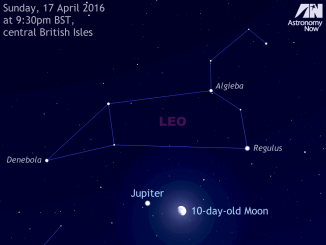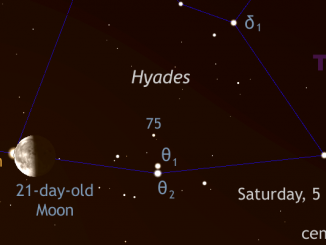
Computer simulations of what followed the collision, sometimes referred to as the “big whack,” show that following this event, and as the young Moon’s orbit was getting bigger, the Earth lost much of its spin as well gained a nearly upright orientation with respect to the ecliptic. The simulations give new insight into the question of whether planets with big moons are more likely to have moderate climates and life.
“Despite smart people working on this problem for fifty years, we’re still discovering surprisingly basic things about the earliest history of our world,” says Matija Cuk a scientist at the SETI Institute and lead researcher for the simulations. “It’s quite humbling.”
Since the nineteenth century, scientists have known that the Moon is gradually moving away from Earth and that our planet’s spin is simultaneously slowing down. The cause is the ocean tides raised by the Moon which slowly dissipate energy as they move across the ocean basins. This energy has to come from somewhere, resulting in a slowing down of Earth’s rotation, with our days very slowly getting longer.
Previous calculations done over many decades always concluded that the Moon formed close to Earth, which at the time had a rotation period of five hours. This calculation later became the basis of the giant-impact theory, in which the Moon formed from debris generated in a collision between proto-Earth and a Mars-sized protoplanet.
However, these calculations may have been missing some important physics. Four years ago, a paper in the journal Science by Cuk and Sarah Stewart (now at the University of California, Davis) suggested that post-impact Earth had a much faster spin, closer to 2 hours. A complex orbital interaction between the Moon and the Sun could have drained spin from the Earth-Moon system, causing an underestimate of Earth’s rotation. Note that a very fast early spin would eject more material from Earth into orbit during and just after the giant impact, producing a Moon that is similar in make-up to Earth’s mantle, as found by laboratory studies of lunar rocks.
Since then, the plot has thickened as it was realised that tides within the Moon significantly affected its orbit during one part of its tidal migration. Today, the path of the Moon is tilted from Earth’s orbital plane by five degrees. Multiple theories have been offered to explain this tilt, but it was never considered significant enough to seriously challenge the idea that the Moon formed in a flat disc around the Earth. However, Erinna Chen and Francis Nimmo at the University of California, Santa Cruz, reported in 2013 that internal friction due to tidal tugs by Earth should have greatly decreased the Moon’s orbital tilt over billions of years. Cuk and Stewart quickly realised a clear implication that the orbit of the Moon once had a large tilt to Earth’s orbit, changing the story of its history completely.
“We’ve been calculating the past orbit of the Moon wrong for over fifty years now,” notes Cuk citing the work of then-doctoral student Chen. “We ignored the fact that tidal flexing within the Moon can decrease lunar orbital inclination.”
In the paper just published in Nature, Cuk and Stewart, together with Douglas Hamilton of the University of Maryland and Simon Lock of Harvard, propose a new solution to the mystery of the lunar orbital tilt, one that also explains the Moon’s Earth-like make-up. They find that, if Earth originally spun on its side with the young Moon orbiting around its equator, solar gravitational forces could both take spin away from the system and tilt the Moon’s orbit.
When the planet’s equator and its orbit are nearly perpendicular, the satellite becomes confused about which way is “up,” and its orbit becomes elongated due to Sun’s meddling. In the case of our Moon, the varying distance from Earth on its eccentric orbit then triggered strong tidal flexing within the Moon which fought back against the efforts of Earth’s tides to push it outward, resulting in a stalemate. Such a stalemate can last for millions of years, during which Earth kept losing its spin while the Moon did not go into a wider orbit. Instead, its orbit became more tilted.
Once the Earth had lost enough of its original spin, the Moon broke out of this stalled state and continued its outward journey. But as the Moon left this special distance, its torque on Earth’s spin axis righted the previously highly-tilted Earth. Finally, as the Moon continued its orbital migration outward, tidal flexing within the Moon shrank its orbital inclination, bringing the lunar orbit closer to the plane of the planets.
Despite the complexity of this story, computer calculations suggest that it is the only complete explanation so far for the current orbital and compositional properties of the Moon.
“This work shows that there are multiple ways a planet could get a small axial tilt, making moderate seasons possible. We thought Earth was this way because of the direction of the giant impact 4.5 billion years ago, but it looks like Earth achieved this state later through a complex interaction with the Moon and the Sun,” Cuk says.
“I wonder how many habitable Earth-like extrasolar planets also have a large Moon,” he asks.



